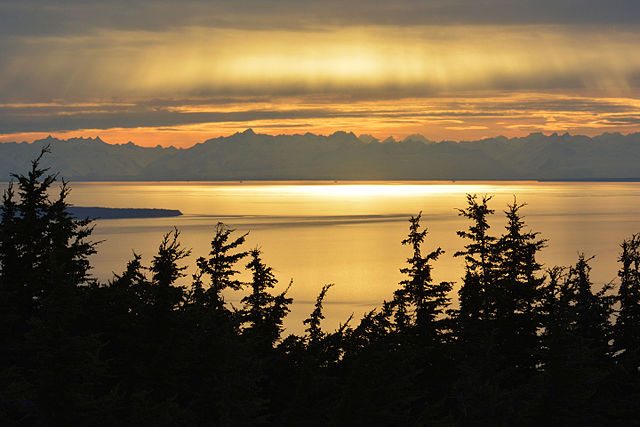
The third decade—clean water, mud-slinging, and nature running wild
in 50th anniversary, America's Arctic, Bristol Bay, Clean Air and Water, Litigation, Wild Lands & Wildlife
By Madison Grosvenor
Trustees for Alaska’s third decade focused heavily on the oil and gas industry’s push to drill across the state– from Cook Inlet near Alaska’s largest city to remote areas of the Arctic where local communities center their ways of life on the land and water that sustains them.
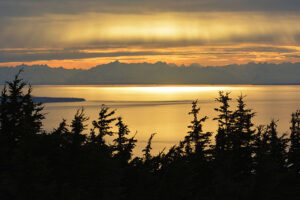
View of Cook Inlet, photo by Paxson Woelber
Oil companies pushed for drilling on the lands below water bodies that sustain abundant life, while oil operators violated the law thousands of times.
There was a lot to watch and do and go to court over for the little Alaska law firm that could—and Trustees did all of that and more.
This watershed ain’t big enough for the both of us
Vicki Clark, Trustees’ executive director, reminisced about a trip to Homer in 1994 when she and a few other interns were slated to spend the night on a Greenpeace boat and talk to the public about the Clean Water Act as well as other federal environmental laws. On an evening run to pick up a pizza at the end of the Homer Spit, she ended up staring at the restaurant’s TV with a slack jaw as an infamous white Ford Bronco evaded the police.
OJ Simpson wasn’t the only one evading the law that year.
Oil companies illegally dumped toxins into waterways thousands of times, so Trustees brought a Clean Water Act citizens’ suit against several oil companies operating in Cook Inlet in 1995. As an intern, one of Vicki’s assignments was to go through the discharge monitoring and pore through and document those thousands of violations.

Bob Shavelson, former Advocacy Director and Inletkeeper, courtesy of Cook Inletkeeper.
Ann Rothe, a former executive director and current board member with Trustees, recalls the over 4,200 toxic dumping violations under the federal Clean Water Act against Shell, Marathon, and Unocal. The U.S. Environmental Protection Agency, finding the allegations incredibly serious, joined the lawsuit. Rather than facing serious penalties in court, the oil companies chose to settle, directing almost 1 million dollars of startup funds to establish Cook Inletkeeper.
Long considered the birthplace of the Alaska oil industry, beluga whales, salmon, and other resources in Cook Inlet suffered harm from hasty and short-sighted industry activities that operated within a “wild west” of destructive practices.
The State of Alaska had leased vast tracts of onshore and offshore lands to the oil and gas industry, with the subsequent construction of a network of offshore platforms with pipelines, refineries, and terminals—all subject to region’s formidable tidal currents, storms, and earthquakes. The oil industry’s threat to this regional ecosystem put a spotlight on the need for Cook Inletkeeper.
Cook Inletkeeper’s role has centered on serving as a “keeper” organization that actively monitors pollution sources, coordinates a citizen response, and provides a network for working together to protect the Inlet.
“Trustees was instrumental in bringing the litigation under the Clean Water Act and helping with the consent decree, which helped shape the organization,” said Bob Shavelson, former executive director of Cook Inletkeeper (1995-2021). “A huge measure of success of Trustees’ work and what the Cook Inletkeeper ultimately became is that the oil industry would never agree to a similar settlement situation again. We were timely and effective.”
During this time, the aftermath of the Exxon Valdez oil spill continued to haunt Alaskans, while the oil industry in upper Cook Inlet maintained a notorious track record of reckless dumping and spills with impunity. Cook Inlet needed a voice.
“The most important component of the Cook Inletkeeper program is that it is a place-based organization,” said Shavelson. “You have Alaska Native members, fisherman, activists, who came together in the wake of the Valdez oil spill. People were coming together and saying this is our home, our subsistence resources, we are not going to let these private corporations come in and take advantage of it.”
Cook Inletkeeper allowed a community to form around the shared goals of monitoring and safeguarding the Cook Inlet watershed’s water quality through advocacy, stewardship, and education. The program continues to do this ambitious work to protect Cook Inlet and the life it sustains.

Vessel christening event in Homer in 1998. All the Federally-recognized Cook Inlet Tribes brought local water (bottles on the table) and we held a “mixing of the waters” ceremony honoring that all our waters are connected. Photo courtesy of Cook Inletkeeper.
Under all that water
The Dinkum Sands case was another landmark win for Trustees. The case involved a land dispute between the federal and state governments over who owns submerged lands along the Arctic coast of Alaska.
In Trustees’ July 1997 newsletter, these submerged lands are described as “the biological heart of the Refuge.” The areas provides integral insect relief for the Porcupine caribou herd, prime denning habitat for polar bears, nesting areas for millions of waterfowl, and important waters for fish and marine mammals.
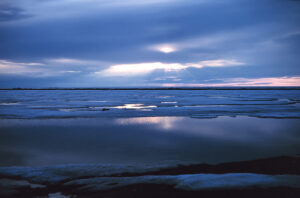
View of Beaufort Sea from Oliktok Point, Photo courtesy of NOAA
The federal government initiated the suit originally in 1979, arguing that the creation of the Arctic Refuge effectively withheld offshore submerged lands that the state had been entitled to when admitted to the union, and that the creation of the Refuge included submerged lands beginning from “the line of extreme low water of the Arctic Ocean” at the Canadian border and following “westerly along the said line of extreme low water, including all offshore bars, reefs, and islands” to Brownlow Point.
“The State going after these submerged lands was yet another sneaky maneuver to push for oil exploration both in and around the Refuge,” said Clark.
Trustees and a coalition of several other environmental groups supported the federal government’s case, and the court sided with us on every point of dispute.
Most notably, the ruling determined that the lands beneath the coastal lagoons and river deltas of the Arctic Refuge are a part of the Refuge. Ownership did not pass to the State of Alaska at the time of statehood, so they could not lease the land for oil and gas as they had intended.
In a 1997 newsletter recounting the win, Peter Van Tuyn said, the “designation of the Refuge would have been meaningless without including these submerged lands within its boundaries. Today’s decision by the U.S. Supreme Court firmly places ownership of these lands into the hands of every citizen of the United States, a great cause for celebration indeed!”
The landmark win in Cook Inlet, the establishment of Cook Inletkeeper, and the Dinkum Sands win allowed Trustees to build great relationships with everyone from fishermen to federal agency folks across the state.
Commercial and sport fisherman, as well as several Alaska-based environmental organizations, rallied behind the causes, becoming important allies and partners.
Trustees’ success gets under the Alaska Legislature’s skin
Prior to 2003, the Alaska Supreme Court established public interest litigant status to protect litigants in public interest cases from having to pay attorney fees if they lost. This status also allowed litigants to recover 100 percent of their fees if they won.
The Alaska Legislature changed that law in 2003, significantly restricting this doctrine to apply only to constitutional claims.
“We were winning our cases, and that angered a lot of legislators,” said Ann Rothe.
The revised law retained the requirement that plaintiffs must not have a “sufficient direct economic incentive” to bring the case. This meant that, to avoid paying attorneys’ fees if they lost or to recover fees if they won, plaintiffs had to demonstrate that their primary motivation was not economic gain.
This legislative change had a significant impact on litigation strategies in Alaska, especially in public interest cases. It became a central issue in the Pebble litigation during our fourth decade, for example, when the State (and Pebble as intervenor) went after our clients for almost 1 million dollars in attorney fees after a loss at the Superior Court (stay tuned for more on Pebble next month).
Whether Trustees liked it or not, the new law had a huge impact on how Trustees made decisions.
“And what triggered this push for public interest law firms to be accountable for their attorney fees?” asked Rothe. “Oil and gas!” This move by the State aimed to streamline the approval process and reduce legal challenges and costs for oil and gas interests in Alaska.
Adding to the drama and tensions of the decade, the Trustees office was repeatedly broken into during these years.
Intruders stole floppy disks, poured Coke onto computers, and even left an ominous note in an Altoids box on Van Tuyn’s desk saying, “We’re watching you!”
Whoever they were, the intruders even took the Altoids!
Tour de Copper River
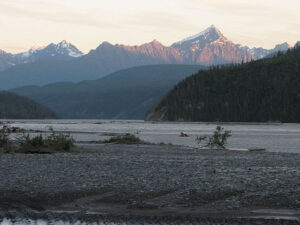
Copper River near Chitina, photo by Doug Noon
Trustees filed a lawsuit in 1994 against the State of Alaska for violating the Clean Water Act in their attempt to build a road from Chitina to Cordova. Governor Wally Hickel had essentially ordered the Alaska Department of Transportation (DOT) to construct the road, ignoring federal law. Once Trustees got wind of this, we quickly got the U.S. Army Corps of Engineers to issue a cease-and-desist order to the State. The Army Corps joined us as plaintiffs.
A joint site visit was planned to discuss and document the violations. The State was supposed to fly U.S. Department of Justice and Army Corps officials, along with Peter Van Tuyn, from Anchorage to Glennallen. From there, they would take State DOT trucks to Chitina and the northern end of what Hickel called the “Copper River Highway.”
They planned to document the sites, then meet up with a river guide client of Trustees, who would take them on his jet boat to access points further south along the river.
However, the evening before the trip, the State’s lawyer called to inform Van Tuyn that he couldn’t travel on the State’s plane due to insurance issues for non-government personnel.
“I went home, and my wife and a friend and I packed our bikes and camping gear into our car and started driving to Chitina eight hours or so away,” said Van Tuyn. “When the DOT caravan pulled into the northern terminus of the work at O’Brien Creek the next morning, to the obvious surprise and consternation of the State folks and laughter of the feds, there I was ready to join the site visit. The State huddled and said, ‘you also cannot ride in our vehicles.’ I said, ‘no matter, I’ll bike along.’ Given the very rough condition of the road, I figured I had a decent chance of keeping pace.”
The weather was wet and the road muddy, which slowed them down even more, so Van Tuyn, covered head to toe in mud, rode just feet from their driver’s side windows. When they realized he could keep up, and how the federal lawyers and Army Corps officials positively reacted to the spectacle, they eventually offered to let Peter ride in one of the trucks. Already close to the jet boat meet-up, the sun came out and the mud dried, and Van Tuyn kept pedaling.
You might say that Trustees has a track record of profound commitment to the work, no matter the mud splattered at us along the way.
The Copper River watershed remains largely roadless today.
Defending and defining
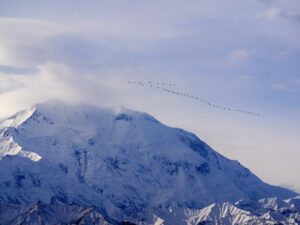
Denali National Park, Photo by Anna Tremewan
At the tail end of the decade, there was a major focus from Trustees in defending the Alaska National Interest Lands Conservation Act, with a significant win for Denali National Park.
In 2000, the National Park Service issued its final regulatory package for Denali National Park, restricting Old Denali (the former Mt. McKinley National Park) to snowmachine use only for traditional activities. This decision followed an extended comment period and internal review after a federal court ruling had required the Park Service to define “traditional activities” under ANILCA.
The court had previously rejected a 1999 temporary rule due to the lack of a clear definition, prompting the Park Service to establish that traditional activities must involve what it called consumptive uses of natural resources, such as hunting and fishing, and to clarify that recreational snowmachine use was not traditional in the original park.
The final regulation applied only to Old Denali, contrasting with the proposed rule that would have affected all Park Service units in Alaska. The new definition of traditional activities excluded recreational activities like picnicking and sightseeing, focusing solely on the Park Service’s definition of consumptive uses.
ANILCA’s legislative history provides no support for an interpretation that would include recreational snowmachining. The legislative history is clear that “traditional activities” and “traditional uses” are linked to hunting, fishing, harvesting, local ways of life, and cultural traditions.
Trustees for Alaska has always fought to ensure that the conservation purposes of ANILCA are implemented as Congress intended.
“The core of Denali National Park has been protected since 1917,” said Van Tyun. “This spectacular landscape includes the largest mountains in the Alaska range, diverse and iconic wildlife and productive and sensitive wildlife habitat. In Denali, the ecosystem functions largely as it has for millennia, and the core Denali Wilderness area ensures that these values will continue to be protected from direct threats into the future. The effort to allow snowmachines in Denali’s core wilderness area would have undercut those values, both for Denali and for Wilderness everywhere. Defeating that effort was therefore critical to the continued integrity of Denali National Park as well as formal Wilderness wherever it may be.”
And so, the sun set on another win and another decade for Trustees, even as the rumblings of the next 10 years were just on the horizon.
Whispers of the decade to come

New York Times Article on Aerial Wolf Hunting in Alaska, 1993
Back in the early 1990s and the Wally Hickel “you can’t let nature run wild” days, the State was killing wolves without accountability. Trustees began working with several clients to try and get a handle on the killing spree.
In response to public outcry in response to a large-scale plan by the State for aerial wolf killing, Governor Hickel put on a “Wolf Summit” in Fairbanks, and he intended for it to be a space where state and national interest groups could meet and discuss the issue. However, the summit ended up merely providing a forum for the various factions to fight in public.
Peter Van Tuyn recalls attending as one of the few delegates representing the conservation community.
“Of course, the State set it up so we would be in the minority by a lot,” he said. “Every day we walked the gauntlet to get into the Carlson Center past a crowd of Fairbanks folks who had dead wolves, wolf skins, moose that had been predated on by wolves, blood frozen in drips, knives in carcasses, people screaming ‘A wolf did this to this moose! How you like wolves now!?’
Trustees attempted to amplify the summit and what it stood for as far and wide as possible. The exposure tamped the program down. Hickel left office soon after, and the ill-conceived “predator control” program died out, at least for a time.
“It really set in motion the egregious predator control methods for the coming years. Something we are still fighting today,” said Clark.
Another hushed conversation was beginning to make its way around, too. “Believe it or not, Pebble mine was still just a whisper on the horizon at this time,” said Ann Rothe.
A new decade of harmful and extractive mining practices was inching closer, and when Pebble got thrown into the mix, ripples would soon follow.


